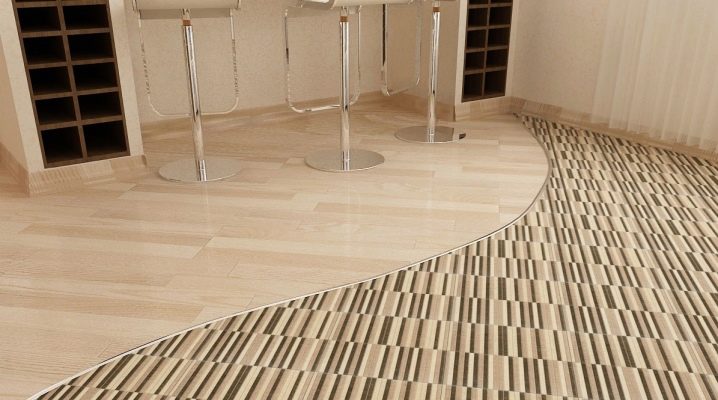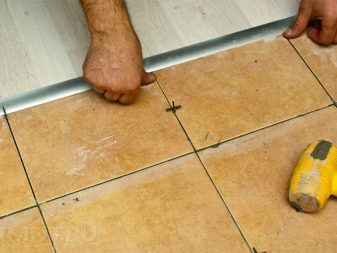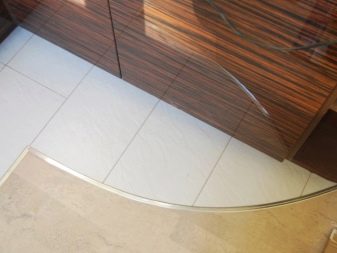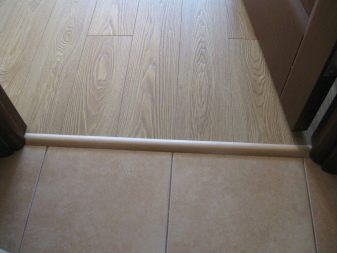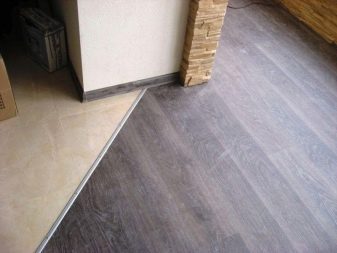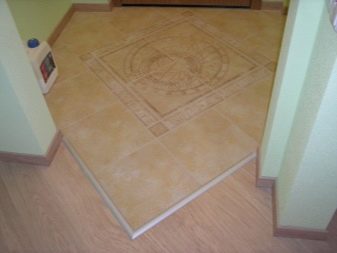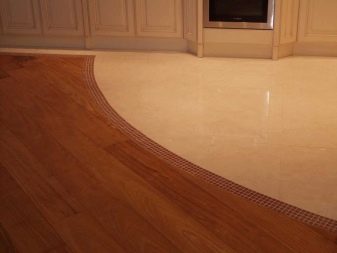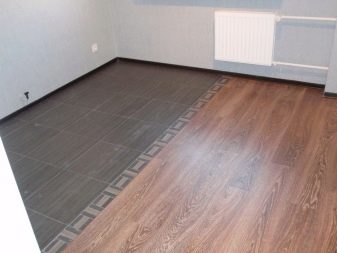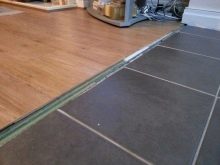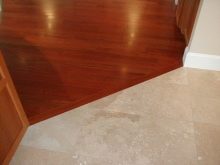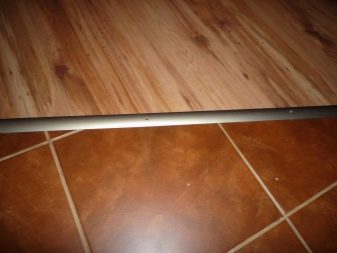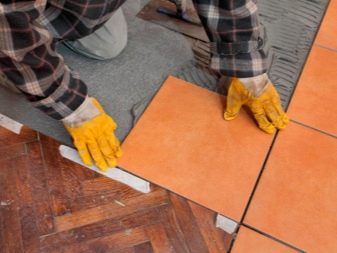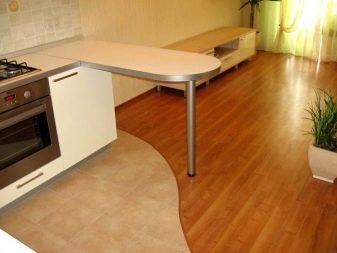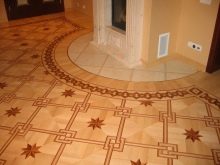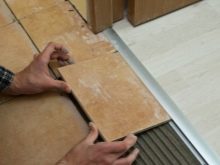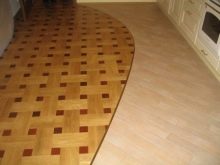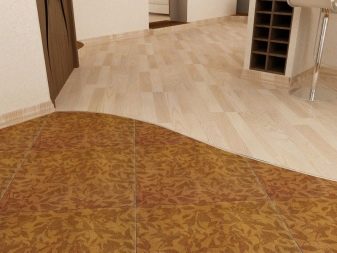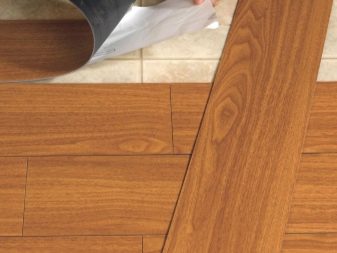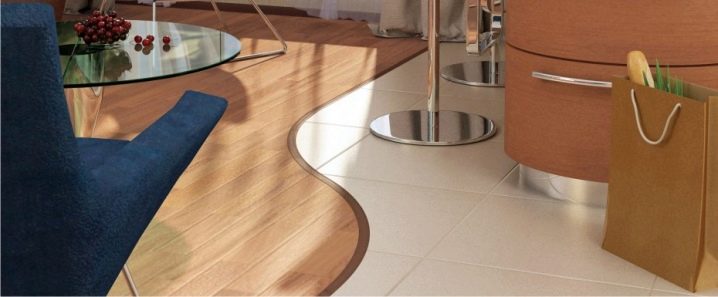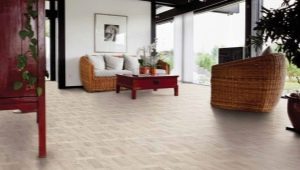How to connect tile and linoleum on the floor?
In the modern interior it is increasingly possible to find a floor covering consisting of different materials. Such a move allows you to add uniqueness and beauty to the space, and in some cases divide the room into two functional zones. For example, when zoning a kitchen, they use ceramics, which will highlight the working area, and linoleum, which emphasizes the dining part. In this way, you can divide any space, as long as it looks appropriate and harmonious.
Varieties of materials
To combine space with the help of two opposing materials, it is necessary to use special thresholds. They can be plastic, aluminum, consist of wood plywood or cork compensator. They are produced in huge quantities, different in appearance, shape and color, which allows each buyer to choose the ideal option for creating a joint.
If the flooring is a semicircular, wavy or other shape, then the metal profile is well suited.
With it, you can combine different forms of floor materials, including multi-level floors.
Cork base is able to change its thickness, tapering and expanding. When installing a compensator, it is necessary to stick it tightly inwards so that it cannot be noticed. Dock ceramics and linoleum is possible without additional fasteners. In this case, only sealant can be used.
Advantages and disadvantages of combined coatings
In modern apartments, it is often possible to find combined floor coverings. This design method makes it possible to rationally use the unique qualities of each material, since the load on the surface can be very different. Often it is found in the kitchen-living room, and sometimes in the hallway.
The load can be carried out not only at the expense of furniture, but also in contact with water, dirt or chemicals. For such areas it is ideal to use tiles that add surface strength and resistance to mechanical stress.
The main advantage of linoleum is its ability to give off heat, which is important for the dining area.
In addition, there are not so many threats in it, which are in the working part of the kitchen.
One more plus of the combined coverings consists in economy of money. Linoleum and tile have a low cost, unlike laminate and natural wood.
It's easy to work with these two materials.therefore, the task of combining can be handled independently. The colors of the coatings are so diverse that you can easily choose the right tone.
Installation rules
Any work requires special training, and therefore starting the connection of tile and linoleum, you must adhere to some rules. Without basic knowledge in the construction field and without the skills to work with tools, it will not be possible to create the perfect floor.
When choosing flooring it is important to consider their color range. They may be the same shade, and may be contrasting with each other. It all depends on the general style of the interior and the purpose of the materials.
If the floor is planned to be multi-level, it is necessary to ensure a smooth transition.It should look as natural as possible and not be obvious.
The height must be such as not to cause discomfort when moving around the room.
Mounting flooring should be careful to monitor the quality of fastening. It should be sufficiently reliable and even so that water and debris do not enter the gap. Qualitatively done work guarantees the floor heat and sound insulation and water resistance.
When buying connecting elements, it is important to pay close attention to their quality. If the threshold is chosen, then you need to make sure that the fasteners are not visible, and its dimensions are equal to specific requirements. The best option is the T-shaped threshold, which reliably combines linoleum and tile and firmly fixes them to the surface.
Ways to dock
Joining of linoleum and tiles can be done in several ways, which differ in the complexity of installation.
Through the nut and profile
Connect the two materials will help aluminum threshold. To do this, just attach the connector with the prepared holes and drill it to the floor. But if the base consists of concrete, then you need to measure the attachment points, make holes, and then fix the plate with the dowel.
You can purchase the nut, which will consist of two bars. One of them should be fixed to the floor surface, and the other on top of the cover. In this case, only the lower bar is mounted, while the upper one is fixed with a special tool. This method is called hidden, because it allows you to hide the cut.
Ceramic tile is thicker than linoleum, therefore it is necessary to balance them when installing.
To do this, you can fill the floor with a solution to raise the rough base. But for this, it is necessary to carefully measure the distance in the place where the linoleum will be located, and pour the solution strictly up to a certain level.
There is the simplest leveling method - the substrate is in the form of a sheet of plywood. To install it, it is necessary to foresee a place for fixing the profile.
To simplify the installation of the threshold, you need to make a recess in the sheet into which one end of the profile will later be inserted, and the other will be fixed under the ceramic. This method is preferable for a beginner.
Profiles can be fixed to the floor with a point attachment. That is, not the entire surface, but at a short distance (30-35 cm). If it has irregularities, then it is necessary to fix the profile on the floor at a distance of 20 cm.
Adhesive bonding
Some people think that the easiest way to fix two different floor materials is with a sealant. However, it is not. To join the linoleum with tile, you have to lay the floor so that the linoleum slightly covers the tile. As soon as both coatings stick, you need to make a pattern of cardboard, which will repeat the shape of the joint. This template must be put on the linoleum, circle the pencil and carefully remove the excess.
Similarly, the line of cut linoleum is applied to the tile, after which it is cut exactly.
To facilitate the work, the sealant is applied a little before reaching the edges, and after the final trimming it is glued. This is especially important if the work is carried out in the corridor under the door.
Regardless of the method of installation, the joints still need to be glued. When they are ready, between them you need to apply adhesive and wait until they dry. It is important to do everything carefully so that the glue is not visible on the tile. At the end of work, all joints are ground with a grout and the surface is cleaned.
If the combined option is chosen when designing the floor in the room, then it is important that both materials are in harmony with each other and with the environment. In this way it will turn out to create a unique and cozy interior.
You will learn more about how to make tile and linoleum joint in the following video.
